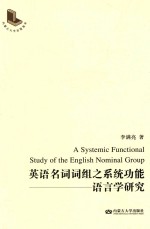

英语名词词组之系统功能语言学研究PDF电子书下载
- 电子书积分:9 积分如何计算积分?
- 作 者:李满亮著
- 出 版 社:呼和浩特:内蒙古大学出版社
- 出版年份:2013
- ISBN:7566503916
- 页数:173 页
Chapter 1:Preliminaries 1
1.1 Panoramic overview of systemic functional syntax 1
1.2 A note on terminology 2
1.3 Research background 3
1.4 Objectives and research questions 5
1.5 Data and methodology 6
1.6 Organization of the book 8
1.7 Summary 9
Chapter 2:Literature Review 10
2.1 Introduction 10
2.2 Traditional approach 10
2.2.1 Jespersen(1924/2008) 10
2.2.2 Quirk et al.(1972,1985) 12
2.2.3 Huddleston(1984) 13
2.2.4 Huddleston and Pullum(2002,2005/2008) 14
2.3 Transformational approach 15
2.4 Corpus-based approach 17
2.4.1 Biber et al.(1999/2000) 17
2.4.2 Carter and McCarthy(2006) 18
2.5 Summary 19
Chapter 3:Theoretical Framework 20
3.1 Introduction 20
3.2 SFL as a comprehensive theory 20
3.3 SFL as an explanatory theory 22
3.4 SFL as a functional theory 24
3.5 SFL as a systemic theory 28
3.6 Summary 30
Chapter 4:Systemic Functional Approach to the English Nominal Group 31
4.1 Introduction 31
4.2 Grammatical categories and scales 31
4.2.1 Categories 32
4.2.2 Scales 36
4.3 Actual analysis of the English nominal group 37
4.3.1 Halliday(1994/2000)and Halliday and Matthiessen(2004) 38
4.3.2 Bloor and Bloor(1995/2001) 41
4.3.3 Thompson(1996/2000) 41
4.3.4 Morley(2000) 42
4.3.5 Fries(2001) 43
4.3.6 The Cardiff Grammar 44
4.3.6.1 Grammatical categories 45
4.3.6.2 Analysis of the English nominal group 47
4.4 Concluding remarks 49
Chapter 5:Head Identification of the English Nominal Group 51
5.1 Introduction 51
5.2 Traditional identification 52
5.3 Systemic functional identification 53
5.3.1 The analysis by Halliday 53
5.3.2 The Cardiff Grammar analysis 55
5.4 Discussion 57
5.4.1 Cultural classification 57
5.4.2 Thing vs.Head 60
5.5 Summary and conclusion 63
Chapter 6:The Quantifying Selection in the English Nominal Group 64
6.1 Introduction 64
6.2 Traditional and transformational analyses 64
6.3 The SFL analysis 66
6.4 Basic concepts of selection 68
6.4.1 Of as a preposition embedded in the prepositional group 68
6.4.2 Of as a selector embedded in the nominal group 70
6.5 Identification of the preposition and the selector 73
6.6 The nominal group with the quantifying selection 74
6.7 Summary and conclusion 78
Chapter 7:The English Nominal Group with a number of 80
7.1 Introduction 80
7.2 Traditional analysis 80
7.3 Transformational analysis 83
7.4 Systemic functional analyses 84
7.4.1 The analysis by Halliday 85
7.4.2 The Cardiff Grammar analysis 86
7.4.3 The analysis by Prakasam 87
7.5 Discussion 89
7.5.1 The functional role of of in the structure 89
7.5.2 Head identification 90
7.5.3 Analysis by delicacy 92
7.6 Summary and conclusion 94
Chapter8:The Selection by Typicity in the English Nominal Group 96
8.1 Introduction 96
8.2 Various types of selections 96
8.3 Alternative analysis of the selection 99
8.4 The selection by typicity 102
8.4.1 Basic concepts 103
8.4.2 Discussion 106
8.4.3 Summary 108
8.5 Analysis of a complex nominal group 109
8.6 Summary and conclusion 111
Chapter 9:The Prepositional Phrase as the Qualifier of the English Nominal Group 112
9.1 Introduction 112
9.2 Various types of Qualifier 113
9.2.1 The clause as the Qualifier 113
9.2.2 The group as the Qualifier 115
9.2.3 The prepositional phrase as the Qualifier 116
9.3 Approaches to the prepositional phrase as the Qualifier 118
9.3.1 Traditional and transformational analyses 118
9.3.2 Systemic functional analyses 119
9.3.2.1 The analysis by Halliday 119
9.3.2.2 The Cardiff Grammar analysis 122
9.4 Discussion 123
9.4.1 Of as a structure marker 123
9.4.2 Of as a minor verb 125
9.4.3 The textual analysis 127
9.5 Summary and conclusion 128
Chapter 10:The English Nominal Group as Grammatical Metaphor 130
10.1 Introduction 130
10.2 Metaphor as a figure of speech 131
10.3 Grammatical metaphor in SFL 132
10.3.1 Lexical metaphor and grammatical metaphor 133
10.3.2 Congruent wording vs.metaphorical wording 135
10.3.3 Metafunctional grammatical metaphor 136
10.3.3.1 Experiential grammatical metaphor 137
10.3.3.2 Interpersonal grammatical metaphor 140
10.3.3.3 Textual grammatical metaphor 142
10.4 The English nominal group as experiential grammatical metaphor 143
10.5 The English nominal group as interpersonal grammatical metaphor 148
10.6 The English nominal group as textual grammatical metaphor 149
10.7 Summary and conclusion 155
Chapter 11:Summary and Conclusions 157
11.1 Introduction 157
11.2 Summarizing overview 157
11.3 Suggestions for further research 162
References 164
- 《程序逻辑及C语言编程》卢卫中,杨丽芳主编 2019
- 《幼儿园课程资源丛书 幼儿园语言教育资源》周兢编 2015
- 《高等学校“十三五”规划教材 C语言程序设计》翟玉峰责任编辑;(中国)李聪,曾志华,江伟 2019
- 《功能涂料》刘仁主编 2018
- 《音乐语言的根基》张艺编著 2019
- 《海洋功能食品》王卉 2019
- 《功能食品 第2版》孟宪军 2017
- 《认知语言学视野的抽象方位结构研究》曹爽著 2019
- 《激活语言思维》李蒨,王宏年,汤青编著 2017
- 《汉语言文学本科专业核心课程研究导引教材 古代汉语》马蓝婕责任编辑;(中国)魏宜辉 2019
- 《一寸光阴一寸暖》周海亮著 2017
- 《洪洞道情》王春亮著 2019
- 《水中盐》房鑫亮著 2019
- 《中国抗日战争史 第1卷 局部抗战》黄道玄,王希亮著;步平,王建朗主编 2019
- 《洪洞鼓乐》王春亮著 2019
- 《中国抗日战争史 第7卷 伪政权与沦陷区》臧运祜,王希亮著;步平,王建朗主编 2019
- 《香学三百问》傅京亮著 2019
- 《洪洞曲艺民歌》王春亮著 2019
- 《深度思考 透过表面看本质的六步思考法》萧亮著 2019
- 《海错图笔记 贰》张辰亮著 2017
- 《大学计算机实验指导及习题解答》曹成志,宋长龙 2019
- 《大学生心理健康与人生发展》王琳责任编辑;(中国)肖宇 2019
- 《大学英语四级考试全真试题 标准模拟 四级》汪开虎主编 2012
- 《大学英语教学的跨文化交际视角研究与创新发展》许丽云,刘枫,尚利明著 2020
- 《复旦大学新闻学院教授学术丛书 新闻实务随想录》刘海贵 2019
- 《大学英语综合教程 1》王佃春,骆敏主编 2015
- 《大学物理简明教程 下 第2版》施卫主编 2020
- 《大学化学实验》李爱勤,侯学会主编 2016
- 《中国十大出版家》王震,贺越明著 1991
- 《近代民营出版机构的英语函授教育 以“商务、中华、开明”函授学校为个案 1915年-1946年版》丁伟 2017
